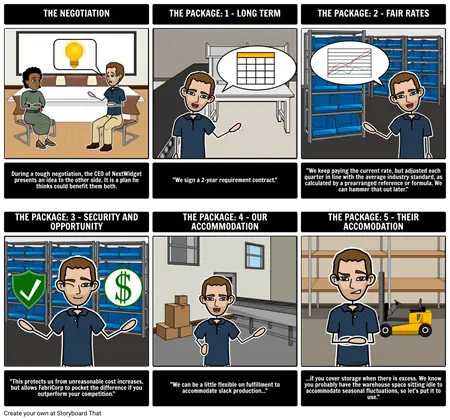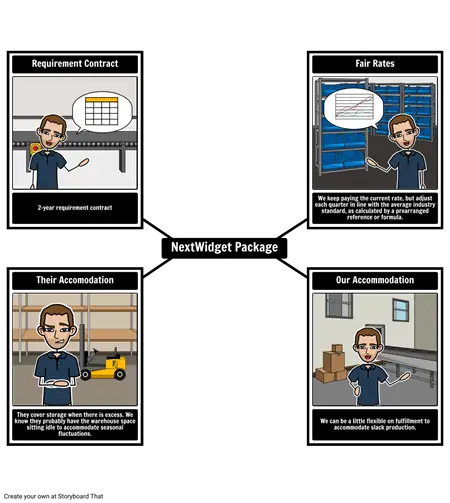Bargaining with Packages

In a traditional negotiation, both sides will come to the table with a list of positions and set about trying to get the best result on each one. Frequently this involves concentrating a single issue until it is completely settled and then going on to slug it out over the next point. This method is called linear, or item-by-item bargaining. It can be an exhausting, frustrating, and lengthy process, but it shows up again and again in divorces, collective bargaining, and international trade talks.
There is an alternative: package bargaining. Unlike item-by-item, packages try to address many issues at the same time. By grouping several items together, concessions can be balanced to maximize the value to each side, even if the monetary value of each isn’t easily assessed. This may seem like common sense, and for smaller negotiations it can be, but when there are dozens of issues under consideration, it can feel easier to hash out each one before moving on.
The linear approach has several benefits; it keeps the agenda orderly and can feel like progress is being made, especially if smaller issues are tackled first. The danger of it is that one item that can’t be resolved threatens to derail the entire process. With packages, each side can feel like they are getting something they want, creating satisfaction and trust that can carry a negotiation through rough patches.
While negotiating packages are frequently used as part of principled negotiations and integrative bargaining, they can be just as effective in distributive bargaining situations. There is no reason why new value needs to be created when negotiating with packages, though integrative bargaining usually isn’t possible without packages.
There are a number of benefits when you bargain with packages, including:
Rationality
Unlike isolated items where a stance can seem arbitrary or self-serving, packages create a sensible and coherent vision. This makes them easier to defend to other negotiators and stakeholders.
Demonstration of Good Faith
Concessions and compromise are an integral part of package bargaining. By showing they are willing to give something up, parties can build trust in each other.
Acknowledgement of Connections
Issues in a negotiation are often linked to each other. By using a package, these connections are acknowledged and accommodated.
Increased Creativity
Expanding the scope of a negotiation from a single issue to a more holistic approach encourages creative solutions. More options means more opportunity, and this can help shift the process from distributive to integrative bargaining.
Palatability
Since the parties have a better chance of getting what they want and a win-win outcome is made more probable, everyone at the table is more likely to agree on a proposal. While not everyone will like everything about a package, it can prevent deadlock and walk-outs.

Practically Speaking
All of this sounds good in theory, but how can you put it into practice? Once you have decided to bargain with packages, here are a few basic steps for negotiation planning to maximize your success:
Draft Early
You can assemble a package even before you know much about the negotiation. Just by reviewing the items under consideration and trying to identify common ground, you’ll have a rough outline of a workable package. This can then be used to direct your investigation, prepare stakeholders, and develop a gameplan for the negotiation.
Revise Frequently
While it’s good to draft some ideas early, it’s important not to stay too attached to them. As you gather more information, both before and during the negotiation, especially about the opposing party, you should revise your initial package. Remember that bargaining packages are solutions to complex problems, and the more you can tailor them to fit the situation, the more satisfied all parties are likely to be. Don’t bargain item by item, but do discuss each item separately so both sides can get a sense of what is at stake and revise their packages.
Present at the Right Time
Deploying your package at the right time is key to making it work. While there is some debate over whether you should try to present first or second, a good rule of thumb is that if you think you have more information, present your offer first. This will anchor the negotiation around your ideas and goals, but does risk being too generous. If you don’t think you’re the best informed at the table, let the other side present first, this will reveal more information to you, and allow you to craft a counter for maximum benefits.
Your package may not always be your first offer. You may hold back on presenting your package until the other side is fatigued and looking for any solution that will settle things, or sufficiently sympathetic that they’ll be receptive to your ideas. You could keep a package as an emergency measure if the negotiation turns against you, but this is very risky.
Defend
Complex solutions don’t always receive warm receptions. Keep in mind that while you have spent time preparing this idea and thinking about the implications, it is new to them. Some negotiators are not used to considering many items at once, or are very wary of the other side. You don’t need to browbeat other negotiators into doing things your way, instead try explaining the benefits of your plan has for both sides. Let them ask questions, give truthful answers, and emphasize that you are presenting the ideas in good faith, as a mutually agreeable solution.
Collaborate
Negotiations are almost always thought of as an adversarial process, but they don’t have to be. If the other party has ideas that could modify your package for the benefit of both sides, consider integrating them. Remember that you won’t always have all, or even most, of the information in a negotiation, and that a successful package will satisfy both sides. Listening to the other party isn’t just a good idea, it’s probably going to be necessary.

Using Storyboard That with Packages
One of the keys to using packages in your negotiation is organization. A spider map is ideal for arranging many issues at a glance, and being able to shift focus between them quickly. Since it is nonlinear, it allows parties to modify or swap components without feeling like the entire plan will fall apart.
A traditional storyboard is another great tool for presenting a package. By implying a narrative structure, the storyboard makes the package feel integrated, logical, and unified. More or less appealing items can be arranged in the storyboard to soften reception and structure reactions.
In the two storyboards below, we can see a package developed and presented by the fictional startup NextWidget in a negotiation with their manufacturer. NextWidget uses bargaining with packages to develop a creative solution they hope can benefit both sides and secure a favorable outcome. For more context, check out our step-by-step guide to negotiation preparation.
Porady dotyczące negocjacji poprzez oferowanie pakietów
Uczyń negocjacje pakietowe interaktywnymi z rolami uczniów
Zachęcaj uczniów do odgrywania scenariuszy negocjacyjnych, przypisując role i kwestie, a następnie tworząc grupy do opracowania i przedstawienia ofert pakietowych. Ten praktyczny sposób rozwija empatię, krytyczne myślenie i umiejętności współpracy, czyniąc abstrakcyjne koncepcje bardziej namacalnymi.
Przygotuj jasne scenariusze negocjacyjne dla uczniów
Projektuj proste studia przypadków lub fikcyjne spory z wieloma powiązanymi kwestiami, które uczniowie mogą rozwiązać poprzez negocjacje pakietowe. Podaj tło, cele i ograniczenia, aby pomóc uczniom skupić się na kreatywnych rozwiązaniach.
Prowadź uczniów do wspólnego burzy mózgów opcji pakietowych
Poproś każdą grupę, aby wypisała możliwe elementy do uwzględnienia w ich pakiecie negocjacyjnym, a następnie omów ich kompromisy i priorytety. Ułatwiaj otwartą dyskusję, aby każda opinia została wysłuchana i eksplorowano kreatywne opcje.
Wspieraj uczniów w prezentowaniu i obronie swoich pakietów
Poproś grupy, aby podzieliły się swoimi propozycjami pakietów z klasą lub inną grupą, wyjaśniając korzyści dla wszystkich stron. Zachęcaj do szacunkowych pytań i informacji zwrotnej, aby budować pewność siebie i umiejętności negocjacyjne.
Refleksja i podsumowanie wyników negocjacji
Przeprowadź dyskusję klasową na temat skutecznych strategii, osiągniętych kompromisów i tego, czego wszyscy nauczyli się o negocjacjach pakietowych. Podkreśl znaczenie kreatywności i współpracy dla udanych negocjacji.
Często zadawane pytania dotyczące negocjacji poprzez oferowanie pakietów
Na czym polega pakietowe negocjowanie w negocjacjach?
Pakietowe negocjacje to podejście, w którym wiele kwestii jest grupowanych i omawianych jako całość, zamiast rozwiązywać każdą pojedynczo. Ta metoda pomaga zrównoważyć ustępstwa, sprzyja kreatywności i zwiększa szanse na korzystne rozwiązanie dla wszystkich stron.
Jak nauczyciele mogą wykorzystać pakietowe negocjacje w zajęciach szkolnych?
Nauczyciele mogą wprowadzić pakietowe negocjacje poprzez scenariusze odgrywania ról, projekty grupowe lub symulacje negocjacji. Uczniowie uczą się łączyć pomysły, balansować interesy i współpracować nad kreatywnymi rozwiązaniami, rozwijając umiejętności rozwiązywania problemów i komunikacji w realnym świecie.
Jakie są główne korzyści z negocjacji pakietowych?
Negocjacje pakietowe oferują korzyści takie jak racjonalne podejmowanie decyzji, okazanie dobrej wiary, uznanie powiązań między kwestiami, zwiększona kreatywność i większa akceptowalność, co ułatwia i uprzyjemnia zawieranie porozumień dla wszystkich stron.
Czym różni się negocjacja pojedynczych pozycji od negocjacji pakietowych?
Negocjacje pojedynczych pozycji rozwiązują każdą kwestię osobno, co może być wolne i prowadzić do impasu. Negocjacje pakietowe obejmują wiele kwestii naraz, umożliwiając zrównoważone wymiany i bardziej efektywne, kreatywne negocjacje.
Jak Storyboard That może pomóc w organizacji negocjacji pakietowych?
Storyboard That wspomaga negocjacje pakietowe, oferując narzędzia wizualne, takie jak mapy pajęczyny i storyboardy. Pomagają one organizować kwestie, jasno przedstawiać oferty i łatwo dokonywać korekt, czyniąc negocjacje bardziej skutecznymi i angażującymi.
- flowchart • Sean MacEntee • Licencja Attribution (http://creativecommons.org/licenses/by/2.0/)
© 2025 - Clever Prototypes, LLC - Wszelkie prawa zastrzeżone.
StoryboardThat jest znakiem towarowym firmy Clever Prototypes , LLC , zarejestrowanym w Urzędzie Patentów i Znaków Towarowych USA

